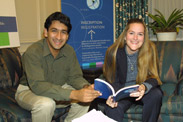In focus
Sherwin Tjia: Hipless wonder

Ryan Kamstra
From the looks of his studio, Sherwin Tjia might be the artist par excellence. Absorbing the multitude of projects peppered throughout his studio is a roller-coaster ride for the eyes. The question soon becomes, what doesn't Tjia do? Poet, graphic novelist, columnist, illustrator, painter, graphic designer... and the list goes on.
Tjia's pursuits seem to grow with every project as one interest metamorphoses into something new but not entirely unconnected from the previous one. "Every time I jump from one medium to another, I combine everything that I've done before," said Tjia.
Tjia's typical workday begins at 10 am, but doesn't end until after midnight. By day, he works for McGill on the Molson Medical Informatics Project. By night, he works on his first graphic novel based on "The Hipless Boy," a column he writes for the McGill Daily.
As part of the team working on the Molson Informatics Project, Tjia creates medical illustrations and enhanced media to accompany doctors' lectures and facilitate student learning. His work helps turn the abstract into something clear and concrete, even for a non-scientist. His images are to be compiled with others developed through the project in a national digital health library.
By the time most people are settling into a relaxing evening, Tjia begins work on his current passion. Funded by the Canada Council, his graphic novel, The Hipless Boy, could be most accurately described as a "thick comic book." It tells the story of Sully, an everyman whose complicated little world may touch a familiar chord for many readers.
The comic format is not entirely new for Tjia, who has already created two volumes of the abrasively funny and somewhat alarming Pedigree Girls (volume two will be on shelves April 1 in the UK). But The Hipless Boy does differ from Pedigree Girls in at least one significant way. While Tjia has been known to pop out 12 strips of Pedigree Girls a day, it takes a week to create three pages of the far more intricately designed The Hipless Boy. With an approximate goal of 140 pages, The Hipless Boy has become a year-long project for Tjia.
Though he has been drawing since the age of three, Sherwin attributes a great deal of his artistic leanings to a "great high school art teacher," with whom he is still in touch. His focus throughout his university career - beginning at Queen's and ending with an MFA from Concordia - had been more traditional. "I really thought I was going to be a painter," he recalls. But the comic book format intrigued him. "Comics add dimensions: time, space, dialogue, personality. Paintings are more of an emotional language. I went into comics because I found it actually let me say things."
And with an already published book of poetry, Gentle Fiction, and another, The World is a Heartbreaker, set to make its appearance in Montreal on May 19, Tjia clearly has many things to say. While the image may have been his catalyst into the world of art, it seems his next ambition is to conquer the written word. As soon as The Hipless Boy is completed, Tjia plans to begin work on his first novel, an FBI thriller about an agent who tracks down a serial killer. "I am fascinated by the catchy, how people become addicted to things." He relates those thrillers that just can't be put down to "cultural narcotics" and parallels the spread in novels such as The DaVinci Code to that of crack cocaine.
Tjia comes across as an ambitious workaholic, constantly spinning out new ideas and turning them into realities. Considering the scope of his endeavours, it is surprising to hear that his ultimate aspiration is to do nothing. "I just want to be able to afford to sleep in every morning."
Read Tjia's Hipless Boy Column online at http://hiplessboy.blogspot.com.
- Jessica Gabe
 |
||||
|
People want to know about what it was like when you were making some discoveries 50 years ago. You are getting it from the horse's mouth. |
||||
CISDL text goes global

Ashfaq Khalfan and Marie-Claire Cordonier Segger
Owen Egan
Former law students Marie-Claire Cordonier Segger and Ashfaq Khalfan are in the middle of a months-long book tour that started at McGill and will wind up in Hong Kong, hitting Oxford, Nairobi, Geneva and Tokyo in between.
The two founded the Centre for International Sustainable Development Law at McGill in 2002. And the tome that's taking them around the world is 'Sustainable Development Law: Principles, Practices and Prospects'
It's meant as a scholarly guide for those dedicated to bringing together environmental, social and economic law. Already professors around the world are considering it for use in their classes, sales have been high in North America and Europe, and it's proving to be a sleeper hit in Japan, Australia, South Africa and Hong Kong.
Sustainable development law is an important new legal area that looks at how best to manage and reconcile the world's resources and ways of living to preserve it for future generations. The need for livelihood is balanced with the needs of environment and culture.
In an email interview, Cordonier Segger said, "We wrote the book, partly as a collaborative project involving all the lawyers and legal scholars in the CISDL. It was a bit of an act of faith. We saw a need for a legal textbook in this area, and so we developed one."
Close to 500 pages later, Cordonier Segger and Khalfan submitted their baby to Oxford University Press and waited nervously for months while it went through the rigorous peer review process. Happily, the reviewers liked it. One wrote that the book could reach an audience of thousands - scholars and environmentalists and governments alike.
Not that their work was done. Laborious proofing and detail checking (where was that treaty citation, again?) took eight more months. Cordonier Segger said other publishers "don't hold a candle" to OUP's support during this period. The press "didn't try to change any of our substantive points, or alter our research directions. They simply helped us to carefully, painstakingly edit and re-edit the book until it was the best first edition that it could be."
Cordonier Segger found the process tiring but rewarding. "There is a very profound inspiration, almost an exhilaration, which is generated by deep intellectual collaboration. When you're both working on the same ideas and original concepts, exploring and developing them, and you're learning from each other's thoughts and proposals at each step. I'd not experienced such a thing to this degree before (except perhaps when working on treaty negotiations, oddly enough!) This 'intellectual joy' was mainly with my co-author, but also with some of the lead counsels who worked on different sections with us.
The book contains the emerging field's principles, as well as examples of innovative practices. And as important as sustainable development law is, there are practical challenges to implementing it, which they address. Fortunately, there are also cutting-edge legal research agendas to explore.
Cordonier Segger and Khalfan have both been awarded full scholarships for doctorate studies in International Law at Oxford. They each have separate book projects on the go, as well as rolling up their sleeves to tackle Volume II for Oxford University Press.
- Maeve Haldane
 |
||||
|
Being a perfectionist and working too hard are not weaknesses and it just doesn't sound genuine. |
||||
